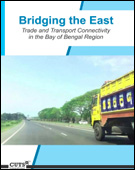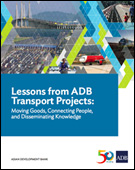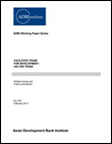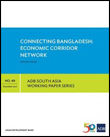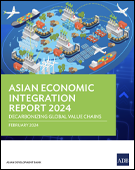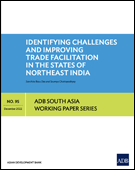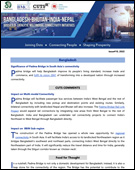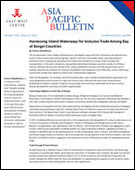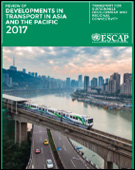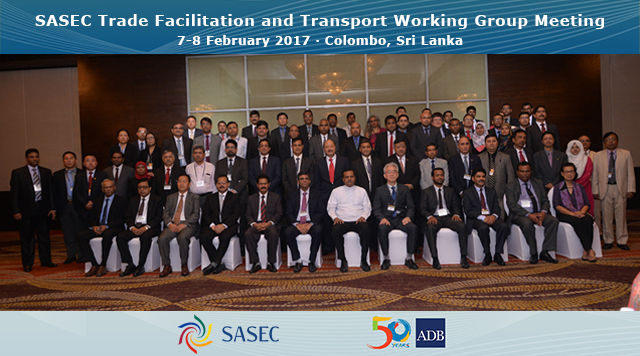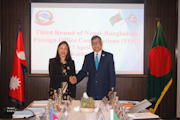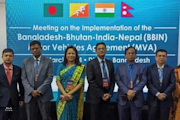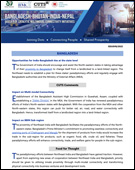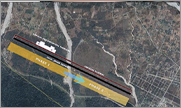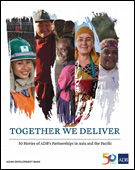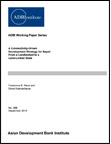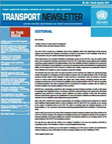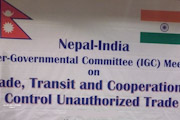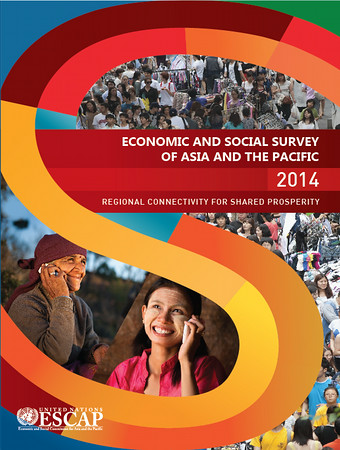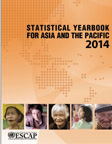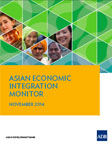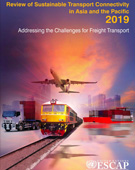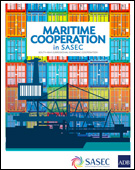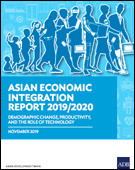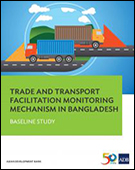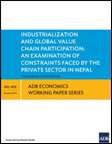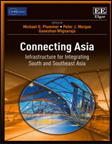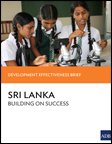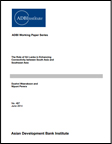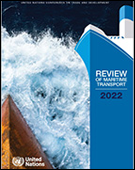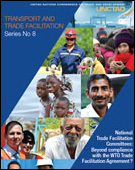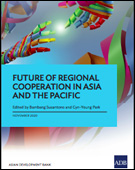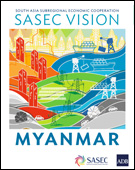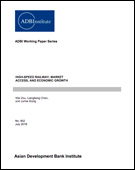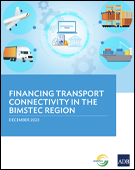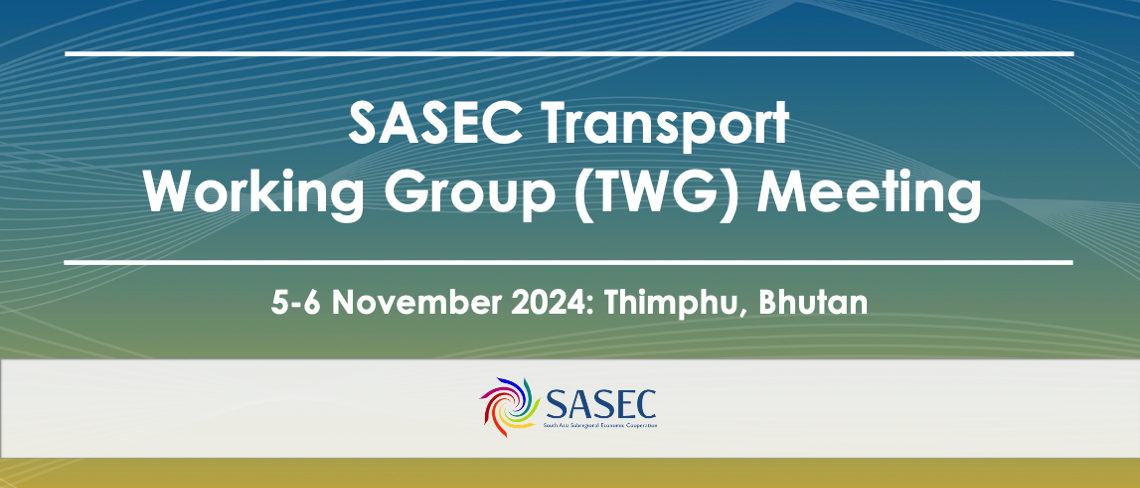Transport
Transport demand in South Asia continues to grow as the region's economies expand, alongside rising incomes, increased consumption, and demand for trade and travel. In South Asia, transport systems have largely developed at a national level, creating the need to develop transport networks in the 21st century that go beyond borders, and address capacity constraints, service quality, and safety. SASEC support for the transport sector facilitates cross-border connectivity by developing multimodal transport systems, including road transport, railways and ports that are aligned with the development of subregional markets.
Search by Topic
Suggested Topics
PUBLICATIONS
showing 3 of 24 VIEW ALLBangladesh, Bhutan, India, and Nepal Motor Vehicles Agreement aims to reap the trade and economic potentials of the countries of South Asia. This study identifies hurdles to the successful implementation of the agreement through evidence-based advocacy and dialogue. The study highlights issues related to infrastructure, political economy, gender, and livelihood.
Source: CUTS International
This publication shares 20 case stories from the Asian Development Bank bearing practical lessons for transport projects across Asia and the Pacific region under different socioeconomic and political situations. The book includes reports on improving aviation in Bhutan, working on computerized transport and trade logistics in Nepal, and constructing Sri Lanka's Greenfield Highway, and the role policy plays in those projects. It also draws lessons from how India's road development increased rural communities' access to public services and economic opportunities, and how participatory processes in selecting road improvement projects in Bangladesh provide a model for long-term plan for road maintenance.
Source: Asian Development Bank
The Aid for Trade program has been providing support to developing economies in tackling obstacles to growth through better facilitation of trade in the last 10 years. Since its launch in 2006, a total of $308 billion has been disbursed to finance aid-for-trade programs and projects, which are working to reduce trade and transport costs, promote trade expansion, and achieve economic and social objectives. As high trade costs persist in keeping developing countries from fully exploiting their trade and development potential, the Aid for Trade program remains highly relevant, and will help developing economies, including landlocked and small and vulnerable economies, achieve the 2030 Agenda for Sustainable Development.
Economic corridors anchored on transport connectivity could significantly boost Bangladesh's economic growth. This paper presents a new set of corridors for Bangladesh – a nine-corridor comprehensive integrated multimodal economic corridor network that will enhance Bangladesh’s role as land bridge between South Asia and Southeast Asia, and between South Asia and northern Asia. These proposed corridors are designed to sustain robust economic growth over the long term by improving regional connectivity, transit, and integration, alongside trade facilitation measures.
Source: Mohuiddin Alamgir
This Asian Development Bank Institute paper examines trade and the main ports around the Bay of Bengal to identify projects that will enable trade and contribute to improved maritime infrastructure. It also reviews the nature of trade and trade patterns, particularly through the Indian East Coast Corridor study. The paper develops further strategic options for seaport adjustment around the Bay of Bengal to support trade evolution, policy assessment, and other constraints.
Source: David Wignall, Mark Wignall
REPORTS
showing 3 of 48 VIEW ALLThis report looks at how economic factors affect the movement of goods, people, and services across borders. As regional economies work to improve economic cooperation, initiatives such as the South Asia Subregional Economic Cooperation (SASEC) strive to improve cross-border trade and connectivity through such projects as the SASEC Chittagong–Cox’s Bazar Railway Project in Bangladesh and the SASEC Highway Enhancement Project in Nepal, and the Visakhapatnam–Chennai Industrial Corridor Development Program in India.
Source: Asian Development Bank
The northeast of India is shares international borders with Bangladesh, Bhutan, Nepal, and Myanmar and acts as a bridge for India's participation in global forums through the Bay of Bengal Initiative for Multisectoral Technical and Economic Cooperation and the South Asia Subregional Economic Cooperation program. This paper highlights challenges in global trade and suggests ways for improving trade with other countries in South Asia and Southeast Asia.
The Padma Bridge will improve connectivity and increase trade in the Bangladesh. The bridge increases connectivity in Bangladesh and is projected to improve the quality of life among nearby communities. The economies of nearby countries also stand to benefit, as the bridge improves connectivity among Bhutan, India, and Nepal, and improves mobility of people, goods, and essential services.
Source: CUTS International
The transboundary rivers Ganges, Brahmaputra, and Meghna create a vibrant water grid connecting Bangladesh, Bhutan, India, and Nepal. India has been developing fairways and river and multimodal terminals in the last few years. Further development of inland waterways in Bay of Bengal countries would create jobs and open opportunities for inclusive trade.
Source: Veena Vidyadharan
This issue of the Review of Development in Transport in Asia and the Pacific looks at how transport development helps achieve the Sustainable Development Goals (SDGs). It also discusses emerging trends that are making transport systems cleaner, safer, and more affordable, and examines how projects including the SASEC Road Connectivity Project in Bangladesh facilitate regional transport operational connectivity.
Source: United Nations Economic and Social Commission for Asia and the Pacific
EVENT MATERIALS
showing 3 of 31 VIEW ALL2017-05-06, Yokohama, Japan
2017-02-07, Colombo, Sri Lanka
2016-11-21, Dhaka, Bangladesh
NEWS & MULTIMEDIA
showing 3 of 187 VIEW ALLThe third round of Foreign Office Consultations between the governments of Bangladesh and Nepal, reviewed bilateral relations and expressed satisfaction with the countries' excellent state of affairs. The meeting agreed to promote cooperation in various sectors, including trade, commerce, transit, connectivity, power, energy, and tourism.
Bhutan is contemplating rejoining the Bangladesh-Bhutan-India-Nepal Motor Vehicles Agreement (BBIN MVA). This development was communicated during a meeting in Dhaka, Bangladesh, focused on the implementation of the BBIN MVA.
Mr. Pranay Verma, Indian High Commissioner to Bangladesh, said the future of Bangladesh-India ties lie in efficient multimodal connectivity, through connectivity via road, rail, inland waterways, and coastal shipping.
PUBLICATIONS
showing 3 of 16 VIEW ALLBangladesh, Bhutan, India, and Nepal Motor Vehicles Agreement aims to reap the trade and economic potentials of the countries of South Asia. This study identifies hurdles to the successful implementation of the agreement through evidence-based advocacy and dialogue. The study highlights issues related to infrastructure, political economy, gender, and livelihood.
Source: CUTS International
The Aid for Trade program has been providing support to developing economies in tackling obstacles to growth through better facilitation of trade in the last 10 years. Since its launch in 2006, a total of $308 billion has been disbursed to finance aid-for-trade programs and projects, which are working to reduce trade and transport costs, promote trade expansion, and achieve economic and social objectives. As high trade costs persist in keeping developing countries from fully exploiting their trade and development potential, the Aid for Trade program remains highly relevant, and will help developing economies, including landlocked and small and vulnerable economies, achieve the 2030 Agenda for Sustainable Development.
This publication shares 20 case stories from the Asian Development Bank bearing practical lessons for transport projects across Asia and the Pacific region under different socioeconomic and political situations. The book includes reports on improving aviation in Bhutan, working on computerized transport and trade logistics in Nepal, and constructing Sri Lanka's Greenfield Highway, and the role policy plays in those projects. It also draws lessons from how India's road development increased rural communities' access to public services and economic opportunities, and how participatory processes in selecting road improvement projects in Bangladesh provide a model for long-term plan for road maintenance.
Source: Asian Development Bank
REPORTS
showing 3 of 40 VIEW ALLThe northeast of India is shares international borders with Bangladesh, Bhutan, Nepal, and Myanmar and acts as a bridge for India's participation in global forums through the Bay of Bengal Initiative for Multisectoral Technical and Economic Cooperation and the South Asia Subregional Economic Cooperation program. This paper highlights challenges in global trade and suggests ways for improving trade with other countries in South Asia and Southeast Asia.
The Padma Bridge will improve connectivity and increase trade in the Bangladesh. The bridge increases connectivity in Bangladesh and is projected to improve the quality of life among nearby communities. The economies of nearby countries also stand to benefit, as the bridge improves connectivity among Bhutan, India, and Nepal, and improves mobility of people, goods, and essential services.
Source: CUTS International
Increased integration in the Bangladesh-Bhutan-India-Nepal (BBIN) subregion is critical for shared economic growth. This report looks at opportunities for strengthening regional, subregional, and bilateral initiatives to increase connectivity. It reviews the impact of these initiatives on multimodal connectivity and its effect on the BBIN subregion.
Source: CUTS International
The transboundary rivers Ganges, Brahmaputra, and Meghna create a vibrant water grid connecting Bangladesh, Bhutan, India, and Nepal. India has been developing fairways and river and multimodal terminals in the last few years. Further development of inland waterways in Bay of Bengal countries would create jobs and open opportunities for inclusive trade.
Source: Veena Vidyadharan
EVENT MATERIALS
showing 3 of 34 VIEW ALL2017-05-06, Yokohama, Japan
2017-02-07, Colombo, Sri Lanka
2016-10-26, Thimphu, Bhutan
NEWS & MULTIMEDIA
showing 3 of 97 VIEW ALLMr. Himanta Biswa Sarma, Chief Minister of Assam, India, discussed plans for Assam's involvement in the development of Bhutan's Gelephu Mindfulness City (GMC) at a press conference. Key highlights of Assam's plans are to build transportation links and expand the airport.
Bhutan officials have selected a master plan by the Asian Development Bank (ADB) for building a new runway for the Gelephu Airport. Under the master plan, a new 3,000-meter-long runway will be built at around 50 to 60 meters above the current runway. The master plan provides an option to extend the runway in the future to 3,500 meters.
Bhutan is contemplating rejoining the Bangladesh-Bhutan-India-Nepal Motor Vehicles Agreement (BBIN MVA). This development was communicated during a meeting in Dhaka, Bangladesh, focused on the implementation of the BBIN MVA.
PUBLICATIONS
showing 3 of 26 VIEW ALLBangladesh, Bhutan, India, and Nepal Motor Vehicles Agreement aims to reap the trade and economic potentials of the countries of South Asia. This study identifies hurdles to the successful implementation of the agreement through evidence-based advocacy and dialogue. The study highlights issues related to infrastructure, political economy, gender, and livelihood.
Source: CUTS International
This publication shares 20 case stories from the Asian Development Bank bearing practical lessons for transport projects across Asia and the Pacific region under different socioeconomic and political situations. The book includes reports on improving aviation in Bhutan, working on computerized transport and trade logistics in Nepal, and constructing Sri Lanka's Greenfield Highway, and the role policy plays in those projects. It also draws lessons from how India's road development increased rural communities' access to public services and economic opportunities, and how participatory processes in selecting road improvement projects in Bangladesh provide a model for long-term plan for road maintenance.
Source: Asian Development Bank
This special edition of Together We Deliver tells 50 stories that highlight the importance of good partnerships in Asia and the Pacific in meeting complex development challenges. In South Asia, ADB has supported infrastructure development and social programs, helping lift people out of poverty in a diverse, rapidly urbanizing subregion. The South Asia Subregional Economic Cooperation Roads Improvement Project, for instance, is set to widen 160 kilometers of Nepal’s East–West Highway, which connects Nepal to India. The improved roads will provide faster and better access to social services and economic opportunities, and will facilitate national and regional integration.
Source: Asian Development Bank
This paper reviews literature estimating the impact of large transport investments. It reviews 78 studies, 11 of which centers on infrastructure projects in India. The paper looks at the economic benefits of transport infrastructure projects to better understand how corridors could generate wider economic benefits, with a focus on roads, rails, and waterways. The review assesses the impact of transport corridor projects on economic welfare and equity, environmental quality, and social inclusion, and suggests a need for policies and institutions that address trade-offs.
Source: Mark Roberts, Martin Melecky, Theophile Bougna, and Yan Sarah Xu
This Asian Development Bank Institute paper examines trade and the main ports around the Bay of Bengal to identify projects that will enable trade and contribute to improved maritime infrastructure. It also reviews the nature of trade and trade patterns, particularly through the Indian East Coast Corridor study. The paper develops further strategic options for seaport adjustment around the Bay of Bengal to support trade evolution, policy assessment, and other constraints.
Source: David Wignall, Mark Wignall
Transforming Nepal from a landlocked into a land-linked state, the authors argue, could be key to unlocking the country's much-awaited growth. With its strategic location between India and the People's Republic of China, a connectivity-driven development strategy could energize Nepal's lackluster post-conflict economic performance. Further, Nepal implements a multi-track approach to promoting regional cooperation and integration in connectivity with its neighbors, reinforced through participation in South Asian Association for Regional Cooperation, Bay of Bengal Initiative for Multi-Sectoral Technical and Economic Cooperation, and South Asia Subregional Economic Cooperation. By identifying ten priority projects that could further boost Nepal's connectivity, the paper also discusses how strengthening Nepal's transport, energy, and trade links could benefit the region. However, the authors also warn against “internal threats” to Nepal's development—corruption and the country's difficult political situation.
REPORTS
showing 3 of 51 VIEW ALLThis report looks at how economic factors affect the movement of goods, people, and services across borders. As regional economies work to improve economic cooperation, initiatives such as the South Asia Subregional Economic Cooperation (SASEC) strive to improve cross-border trade and connectivity through such projects as the SASEC Chittagong–Cox’s Bazar Railway Project in Bangladesh and the SASEC Highway Enhancement Project in Nepal, and the Visakhapatnam–Chennai Industrial Corridor Development Program in India.
Source: Asian Development Bank
The northeast of India is shares international borders with Bangladesh, Bhutan, Nepal, and Myanmar and acts as a bridge for India's participation in global forums through the Bay of Bengal Initiative for Multisectoral Technical and Economic Cooperation and the South Asia Subregional Economic Cooperation program. This paper highlights challenges in global trade and suggests ways for improving trade with other countries in South Asia and Southeast Asia.
The Padma Bridge will improve connectivity and increase trade in the Bangladesh. The bridge increases connectivity in Bangladesh and is projected to improve the quality of life among nearby communities. The economies of nearby countries also stand to benefit, as the bridge improves connectivity among Bhutan, India, and Nepal, and improves mobility of people, goods, and essential services.
Source: CUTS International
The transboundary rivers Ganges, Brahmaputra, and Meghna create a vibrant water grid connecting Bangladesh, Bhutan, India, and Nepal. India has been developing fairways and river and multimodal terminals in the last few years. Further development of inland waterways in Bay of Bengal countries would create jobs and open opportunities for inclusive trade.
Source: Veena Vidyadharan
This United Nations Conference on Trade and Development (UNCTAD) newsletter focuses on the development dimension and benefits of the World Trade Organization Trade Facilitation Agreement. It includes sections on the national trade facilitation committees, project proposal for the implementation of trade facilitation measures contained in the agreement, and improvement in implementation of sanitary and phytosanitary measures to facilitate trade. It also includes UNCTAD’s contribution to trade facilitation in Landlocked Developing Countries and Small Island Developing States.
EVENT MATERIALS
showing 3 of 37 VIEW ALL2018-02-27, Kathmandu, Nepal
2017-05-06, Yokohama, Japan
2017-02-07, Colombo, Sri Lanka
NEWS & MULTIMEDIA
showing 3 of 231 VIEW ALLThe India-Nepal Inter-Governmental Committee (IGC) on Trade, Transit, and Cooperation to Combat Unauthorized Trade conducted a comprehensive review of India – Nepal trade and economic cooperation.
Mr. Himanta Biswa Sarma, Chief Minister of Assam, India, discussed plans for Assam's involvement in the development of Bhutan's Gelephu Mindfulness City (GMC) at a press conference. Key highlights of Assam's plans are to build transportation links and expand the airport.
India Prime Minister Narendra Modi and Sri Lanka President Anura Kumara Disanayaka held comprehensive discussions on 16 December 2024 in New Delhi, India. Both leaders affirmed their commitment to further enhance the relationship and emphasized cooperation in various areas, including connectivity, energy, trade, and tourism.
PUBLICATIONS
showing 3 of 10 VIEW ALLThis 2014 edition of UNESCAP's flagship publication emphasizes the importance of furthering regional connectivity in Asia-Pacific—a region which, despite significant reductions in poverty levels, is now witnessing rising income inequality, both within and between countries. It calls for driving the region's growth by exploiting the interdependence and synergies of five elements: trade and transport connectivity, ICT networks, energy connectivity, people-to-people networks, and promotion of knowledge-based economies, and advocates approaching connectivity as a regional public good.
Source: UNESCAP
The Statistical Yearbook contains comparative statistics and facts about the 58 regional members and associate members of the Economic and Social Commission for Asia and the Pacific. It includes brief analyses of 32 key development features such as energy supply and use, international trade, and transport, among others. In energy, the region’s production structure is highly resource-intensive, although per capita energy use is low. The section on international trade recommends focusing on raising domestic value-added rather than increasing gross exports in Asia and the Pacific. Finally, investment in environmentally sustainable transport is encouraged.
Source: United Nations Economic and Social Commission for Asia and the Pacific
This AEIM review of recent economic performance highlights the need for Asia to rebalance its sources of growth toward domestic and regional demand. It also shows a resilient Asia with rising GDP growth in South Asia. This issue includes a Special Chapter: Regional Financial Integration and Crisis in Asia and Europe – A Comparative Analysis. It presents Asia’s future path of integration as different from that in Europe. Asia will continue to strengthen efforts to harmonize rules and regulations in the financial sector and further unilateral trade and investment, while Europe is more likely to strengthen regional institutions to ensure recovery and better the monetary union.
Source: Asian Development Bank
REPORTS
showing 3 of 27 VIEW ALLA dominantly road-centric and fossil fuel dependent freight transport sector has made Asia and the Pacific one of the highest CO2 emitting regions in the world, while making the regional transport system more vulnerable to climate disasters. Shifting to sustainable freight transport will be driven by technology and innovation, but it will also need public policy that promotes better transport connectivity within the region.
Source: United Nations Economic and Social Commission for Asia and the Pacific
Most South Asia Subregional Economic Cooperation (SASEC) countries rely on maritime transport for international trade. Stronger maritime relations are crucial to achieve the economic growth potential for the subregion. This report looks at how countries can strengthen international trade by improving maritime cooperation among the SASEC countries, comprised of Bangladesh, Bhutan, India, Maldives, Myanmar, Nepal, and Sri Lanka. It gives an overview of the SASEC maritime sector and identifies collaboration initiatives that could address key challenges.
Source: Asian Development Bank
This report reviews economic cooperation and integration in Asia and the Pacific. It reports that in 2018, the South Asia Subregional Economic Cooperation (SASEC) focused on reducing gaps in multimodal connectivity among its member countries. By the end of 2018, 52 ADB-financed projects worth $11.36 billion had been committed to SASEC projects, with an additional $106.44 million in 81 technical assistance grants. SASEC nodal officials and working groups met in Singapore in March 2018 to update the SASEC operational plan. The operational plan identified 77 projects ($45.6 billion) to be financed by SASEC members, ADB, and development partners. A holistic approach under the operational plan will build transport links with Southeast Asia and East Asia and expand regional trade markets.
Source: Asian Development Bank
EVENT MATERIALS
showing 3 of 10 VIEW ALL2017-05-06, Yokohama, Japan
2017-02-07, Colombo, Sri Lanka
2016-11-15, Male, Maldives
NEWS & MULTIMEDIA
showing 3 of 14 VIEW ALLIndia External Affairs Minister Subrahmanyam Jaishankar called on Maldives President Ibrahim Mohamed Solih during his visit to Maldives. They jointly participated in the groundbreaking ceremony of the Hanimaadhoo international airport project.
Mr. Abdulla Shahid, Foreign Minister of the Government of Maldives, met with Mr. S Jaishankar, Foreign Minister of the Government of India, on 16 April 2021, as part of his two-day visit to India. The two foreign ministers reviewed the status of ongoing projects in Maldives backed by India. India supports around $2 billion worth of projects in Maldives, including ports, roads, bridges, water and sanitation, and socio-economic development projects.
India could play a crucial role in interconnecting regional energy networks. In this commentary, Mr. Mahendra P. Lama outlines what India needs to approach energy security projects in India and its neighboring countries.
PUBLICATIONS
showing 3 of 21 VIEW ALLBangladesh, Bhutan, India, and Nepal Motor Vehicles Agreement aims to reap the trade and economic potentials of the countries of South Asia. This study identifies hurdles to the successful implementation of the agreement through evidence-based advocacy and dialogue. The study highlights issues related to infrastructure, political economy, gender, and livelihood.
Source: CUTS International
This report synthesizes the business process analysis conducted on the export of plastic kitchenware and tableware from Bangladesh to Bhutan through Burimari land port, and the import of lentils from Nepal to Bangladesh through Banglabandha land port, as well as studies on trade corridors and border crossings in Bangladesh, to quantify current trade and transport facilitation in Bangladesh through a set of indicators. Findings of the study reveal bottlenecks to trade, including costly one-time procedures for a new trader, numerous documents and copies required to complete export and import processes, and low speed along the trade corridors. This report includes specific short-term and long-term policies to improve Bangladesh’s trade and transport facilitation.
Source: Asian Development Bank
This special edition of Together We Deliver tells 50 stories that highlight the importance of good partnerships in Asia and the Pacific in meeting complex development challenges. In South Asia, ADB has supported infrastructure development and social programs, helping lift people out of poverty in a diverse, rapidly urbanizing subregion. The South Asia Subregional Economic Cooperation Roads Improvement Project, for instance, is set to widen 160 kilometers of Nepal’s East–West Highway, which connects Nepal to India. The improved roads will provide faster and better access to social services and economic opportunities, and will facilitate national and regional integration.
Source: Asian Development Bank
Transforming Nepal from a landlocked into a land-linked state, the authors argue, could be key to unlocking the country's much-awaited growth. With its strategic location between India and the People's Republic of China, a connectivity-driven development strategy could energize Nepal's lackluster post-conflict economic performance. Further, Nepal implements a multi-track approach to promoting regional cooperation and integration in connectivity with its neighbors, reinforced through participation in South Asian Association for Regional Cooperation, Bay of Bengal Initiative for Multi-Sectoral Technical and Economic Cooperation, and South Asia Subregional Economic Cooperation. By identifying ten priority projects that could further boost Nepal's connectivity, the paper also discusses how strengthening Nepal's transport, energy, and trade links could benefit the region. However, the authors also warn against “internal threats” to Nepal's development—corruption and the country's difficult political situation.
This paper examines the constraints behind and beyond Nepal's borders that hinder its full participation in global value chains (GVC). Basing the analysis on recent and relevant publications, key economic data, and interviews with policymakers and stakeholders, the authors explain how weak and uncertain industrial policy has led to de-industrialization. They also looked at the effects of inadequate infrastructure, energy shortage, and inefficient transit. Failures in coordination, shallow regional integration and non-tariff barriers also bar further growth of Nepal's industrial development and GVC participation. The authors recommend necessary domestic reforms for behind-the-border constraints, and subregional partnerships—facilitated through the South Asia Subregional Economic Cooperation program—for beyond-the-border challenges.
REPORTS
showing 3 of 37 VIEW ALLThe northeast of India is shares international borders with Bangladesh, Bhutan, Nepal, and Myanmar and acts as a bridge for India's participation in global forums through the Bay of Bengal Initiative for Multisectoral Technical and Economic Cooperation and the South Asia Subregional Economic Cooperation program. This paper highlights challenges in global trade and suggests ways for improving trade with other countries in South Asia and Southeast Asia.
Increased integration in the Bangladesh-Bhutan-India-Nepal (BBIN) subregion is critical for shared economic growth. This report looks at opportunities for strengthening regional, subregional, and bilateral initiatives to increase connectivity. It reviews the impact of these initiatives on multimodal connectivity and its effect on the BBIN subregion.
Source: CUTS International
The Padma Bridge will improve connectivity and increase trade in the Bangladesh. The bridge increases connectivity in Bangladesh and is projected to improve the quality of life among nearby communities. The economies of nearby countries also stand to benefit, as the bridge improves connectivity among Bhutan, India, and Nepal, and improves mobility of people, goods, and essential services.
Source: CUTS International
The transboundary rivers Ganges, Brahmaputra, and Meghna create a vibrant water grid connecting Bangladesh, Bhutan, India, and Nepal. India has been developing fairways and river and multimodal terminals in the last few years. Further development of inland waterways in Bay of Bengal countries would create jobs and open opportunities for inclusive trade.
Source: Veena Vidyadharan
EVENT MATERIALS
showing 3 of 34 VIEW ALL2018-02-27, Kathmandu, Nepal
2017-05-06, Yokohama, Japan
2017-02-07, Colombo, Sri Lanka
NEWS & MULTIMEDIA
showing 3 of 114 VIEW ALLThe India-Nepal Inter-Governmental Committee (IGC) on Trade, Transit, and Cooperation to Combat Unauthorized Trade conducted a comprehensive review of India – Nepal trade and economic cooperation.
The third round of Foreign Office Consultations between the governments of Bangladesh and Nepal, reviewed bilateral relations and expressed satisfaction with the countries' excellent state of affairs. The meeting agreed to promote cooperation in various sectors, including trade, commerce, transit, connectivity, power, energy, and tourism.
Bhutan is contemplating rejoining the Bangladesh-Bhutan-India-Nepal Motor Vehicles Agreement (BBIN MVA). This development was communicated during a meeting in Dhaka, Bangladesh, focused on the implementation of the BBIN MVA.
PUBLICATIONS
showing 3 of 21 VIEW ALLThis publication shares 20 case stories from the Asian Development Bank bearing practical lessons for transport projects across Asia and the Pacific region under different socioeconomic and political situations. The book includes reports on improving aviation in Bhutan, working on computerized transport and trade logistics in Nepal, and constructing Sri Lanka's Greenfield Highway, and the role policy plays in those projects. It also draws lessons from how India's road development increased rural communities' access to public services and economic opportunities, and how participatory processes in selecting road improvement projects in Bangladesh provide a model for long-term plan for road maintenance.
Source: Asian Development Bank
This book contains background papers prepared for the Asian Development Bank and the Asian Development Bank Institute joint study, 'Connecting South Asia and Southeast Asia.' It emphasizes the potential contribution to growth that greater connectivity—through better transport and energy infrastructure and improved soft infrastructure, including trade facilitation—between South Asia and Southeast Asia can foster. With benefits including greater participation in global supply chains for South Asia; lower trade costs; and increase in inter- and intraregional trade, the book underscores that, at a juncture where closer regional integration can secure sustainable and inclusive growth for economies in the two regions, specific policies should be examined and considered to enable both regions to maximize gains from greater integration.
Source: Michael G. Plummer, Peter J. Morgan, Ganeshan Wignaraja, eds.
Over the years, the Asian Development Bank (ADB) and its many partners in Sri Lanka have worked together to realize the goal of changing the country’s status from low to middle income. With Sri Lanka moving toward becoming an upper middle-income country in a few years, challenges lie on the road ahead. This publication provides an overview of recent ADB support toward Sri Lanka's development in diverse areas including transport, energy and education, and discusses how the Government of Sri Lanka and ADB will transition their partnership to push the country to the next level of prosperity.
Source: Asian Development Bank
As Sri Lanka rebuilds at the end of a 30-year conflict, its progress in improving physical infrastructure—including the Colombo port expansion and other programs for new expressways and road connectivity—has been significant. Yet, the country has seen a sharp decline in its overall exports-to-gross domestic product ratio. How Sri Lanka can benefit from greater connectivity with its neighbors in South Asia and Southeast Asia is discussed in this paper. Trade policies geared towards enhancing regional integration efforts could boost Sri Lanka's economy. Additionally, to lessen the challenges of financing and sustaining implementation of planned infrastructure development efforts, Sri Lanka could also implement a more stringent institutional and regulatory environment encouraging more private sector participation.
This Asian Development Bank Institute paper examines trade and the main ports around the Bay of Bengal to identify projects that will enable trade and contribute to improved maritime infrastructure. It also reviews the nature of trade and trade patterns, particularly through the Indian East Coast Corridor study. The paper develops further strategic options for seaport adjustment around the Bay of Bengal to support trade evolution, policy assessment, and other constraints.
Source: David Wignall, Mark Wignall
REPORTS
showing 3 of 28 VIEW ALLShips carry over 80% of the volume of global trade. In South Asia, intraregional shipping connections increased as India improved its shipping connections to Pakistan, Sri Lanka, People's Republic of China, the Republic of Korea, Malaysia, Saudi Arabia, Singapore, and the United Arab Emirates. The most connected port in South Asia is the Colombo port in Sri Lanka; the Colombo port ranked the 24th best port in the world in 2021.
A dominantly road-centric and fossil fuel dependent freight transport sector has made Asia and the Pacific one of the highest CO2 emitting regions in the world, while making the regional transport system more vulnerable to climate disasters. Shifting to sustainable freight transport will be driven by technology and innovation, but it will also need public policy that promotes better transport connectivity within the region.
Source: United Nations Economic and Social Commission for Asia and the Pacific
Most South Asia Subregional Economic Cooperation (SASEC) countries rely on maritime transport for international trade. Stronger maritime relations are crucial to achieve the economic growth potential for the subregion. This report looks at how countries can strengthen international trade by improving maritime cooperation among the SASEC countries, comprised of Bangladesh, Bhutan, India, Maldives, Myanmar, Nepal, and Sri Lanka. It gives an overview of the SASEC maritime sector and identifies collaboration initiatives that could address key challenges.
Source: Asian Development Bank
This study presents analysis of 59 national trade facilitation committees from around the world, based on a survey by the United Nations Conference on Trade and Development. It outlines how countries are applying the World Trade Organization Trade Facilitation Agreement article number 23.2 relating to the formation of national committees on trade facilitation. The study includes analysis of national trade facilitation committees’ institutional frameworks, composition, gender mainstreaming policies, communications activities, and financing sources. It also gives a summary of outcomes, obstacles faced, and lessons learned by the committees.
EVENT MATERIALS
showing 3 of 12 VIEW ALL2017-05-06, Yokohama, Japan
2017-02-07, Colombo, Sri Lanka
2016-11-18, Colombo, Sri Lanka
NEWS & MULTIMEDIA
showing 3 of 33 VIEW ALLIndia Prime Minister Narendra Modi and Sri Lanka President Anura Kumara Disanayaka held comprehensive discussions on 16 December 2024 in New Delhi, India. Both leaders affirmed their commitment to further enhance the relationship and emphasized cooperation in various areas, including connectivity, energy, trade, and tourism.
The passenger ferry service from Nagapattinam, Tamil Nadu, India, to Kankesanthurao, Jaffna, Sri Lanka, was inaugurated on 14 October 2023. It is expected to bring the two nations closer together and benefit local traders of both countries, boost tourism, and increase people-to-people relations.
Cordelia Express, the first luxury cruise ship between India and Sri Lanka, was flagged off on 5 June 2023 from Chennai Port, India. It set sail for Hambantota Port, Sri Lanka, and Trincomalee, Sri Lanka, and sailed back to Chennai on 9 June. Mr. Jurgen Bailom, Chief Executive Officer of the Cordelia Express, noted that the cruise ship is set to carry 50,000 passengers from India to Sri Lanka in the next four months.
PUBLICATIONS
showing 3 of 46 VIEW ALLThe book reviews how Asia and the Pacific can leverage regional cooperation to realize the region’s economic potential. Subregional initiatives such as the South Asia Subregional Economic Cooperation (SASEC) Program could support regional public goods, including road, energy, communication, and railway networks. SASEC is also promoting the development of economic corridors, the strategy for which was introduced in the SASEC Operational Plan 2016–2025.
Bangladesh, Bhutan, India, and Nepal Motor Vehicles Agreement aims to reap the trade and economic potentials of the countries of South Asia. This study identifies hurdles to the successful implementation of the agreement through evidence-based advocacy and dialogue. The study highlights issues related to infrastructure, political economy, gender, and livelihood.
Source: CUTS International
Myanmar serves as a land bridge between South Asia, Southeast Asia, and East Asia. This book identifies regional and subregional opportunities for Myanmar to harness natural and human resources, industrial potential, and infrastructure connectivity as part of the South Asia Subregional Economic Cooperation (SASEC) program. SASEC Vision – Myanmar serves to supplement the 2017 SASEC Vision document, which articulates shared aspirations of the SASEC countries and sets the path to achieve these through regional collaboration.
WORKING PAPER
showing 3 of 13 VIEW ALLThis paper reviews literature estimating the impact of large transport investments. It reviews 78 studies, 11 of which centers on infrastructure projects in India. The paper looks at the economic benefits of transport infrastructure projects to better understand how corridors could generate wider economic benefits, with a focus on roads, rails, and waterways. The review assesses the impact of transport corridor projects on economic welfare and equity, environmental quality, and social inclusion, and suggests a need for policies and institutions that address trade-offs.
Source: Mark Roberts, Martin Melecky, Theophile Bougna, and Yan Sarah Xu
This paper asserts that advances in information technology have allowed companies to know more about individual consumers. This has challenged theories that assume consumers to be identical, where goods and services that enter regional value chains are slow to respond to changing demands. The paper predicts that countries and firms will succeed depending on how they will integrate consumer information into the process of value addition.
Source: Matthias Helble
High-speed railway in the People’s Republic of China exerts positive impact effects on growth, where a 1% increase in market access leads to an increase of 0.12% in real income. Drawing insights from the effects of transport infrastructure in India, this paper suggests that high-speed railway could help promote regional cooperation and stimulate regional economic growth.
REPORTS
showing 3 of 88 VIEW ALLThis report looks at how economic factors affect the movement of goods, people, and services across borders. As regional economies work to improve economic cooperation, initiatives such as the South Asia Subregional Economic Cooperation (SASEC) strive to improve cross-border trade and connectivity through such projects as the SASEC Chittagong–Cox’s Bazar Railway Project in Bangladesh and the SASEC Highway Enhancement Project in Nepal, and the Visakhapatnam–Chennai Industrial Corridor Development Program in India.
Source: Asian Development Bank
Financing Transport Connectivity in the BIMSTEC Region looks at how to finance an overhaul of transport infrastructure in the Bay of Bengal Initiative for Multi-Sectoral Technical and Economic Cooperation (BIMSTEC) subregion. The report identifies institutional gaps in the BiMSTEC regional institutions compared with regional institutions in the European Commission, Association of Southeast Asian Nations, and the South Asia Subregional Economic Cooperation (SASEC) partnership.
Source: Asian Development Bank
The northeast of India is shares international borders with Bangladesh, Bhutan, Nepal, and Myanmar and acts as a bridge for India's participation in global forums through the Bay of Bengal Initiative for Multisectoral Technical and Economic Cooperation and the South Asia Subregional Economic Cooperation program. This paper highlights challenges in global trade and suggests ways for improving trade with other countries in South Asia and Southeast Asia.
PERIODICALS
showing 3 of 6 VIEW ALLThe transboundary rivers Ganges, Brahmaputra, and Meghna create a vibrant water grid connecting Bangladesh, Bhutan, India, and Nepal. India has been developing fairways and river and multimodal terminals in the last few years. Further development of inland waterways in Bay of Bengal countries would create jobs and open opportunities for inclusive trade.
Source: Veena Vidyadharan
Trade Insight is published by the South Asia Watch on Trade, Economics and Environment. This issue includes discussions on various aspects of e-commerce, such as cryptocurrencies, integration of small and medium enterprises, and competition and regulation. Its editorial argues that South Asia should take an active part in drafting global rules on e-commerce. The issue also includes features on the South Asian Association for Regional Cooperation investment agreement, Connectivity 2.0 for the South Asia Economic Union, the use of inland waterways, and the electronic cargo tracking system.
Source: South Asia Watch on Trade, Economics and Environment
This issue of the Review of Development in Transport in Asia and the Pacific looks at how transport development helps achieve the Sustainable Development Goals (SDGs). It also discusses emerging trends that are making transport systems cleaner, safer, and more affordable, and examines how projects including the SASEC Road Connectivity Project in Bangladesh facilitate regional transport operational connectivity.
Source: United Nations Economic and Social Commission for Asia and the Pacific
EVENT MATERIALS
showing 3 of 63 VIEW ALL2024-11-05, Thimphu, Bhutan
2019-06-24, Kathmandu, Nepal
2018-02-27, Kathmandu, Nepal
NEWS & MULTIMEDIA
showing 3 of 388 VIEW ALLThe India-Nepal Inter-Governmental Committee (IGC) on Trade, Transit, and Cooperation to Combat Unauthorized Trade conducted a comprehensive review of India – Nepal trade and economic cooperation.
Mr. Himanta Biswa Sarma, Chief Minister of Assam, India, discussed plans for Assam's involvement in the development of Bhutan's Gelephu Mindfulness City (GMC) at a press conference. Key highlights of Assam's plans are to build transportation links and expand the airport.
India Prime Minister Narendra Modi and Sri Lanka President Anura Kumara Disanayaka held comprehensive discussions on 16 December 2024 in New Delhi, India. Both leaders affirmed their commitment to further enhance the relationship and emphasized cooperation in various areas, including connectivity, energy, trade, and tourism.

